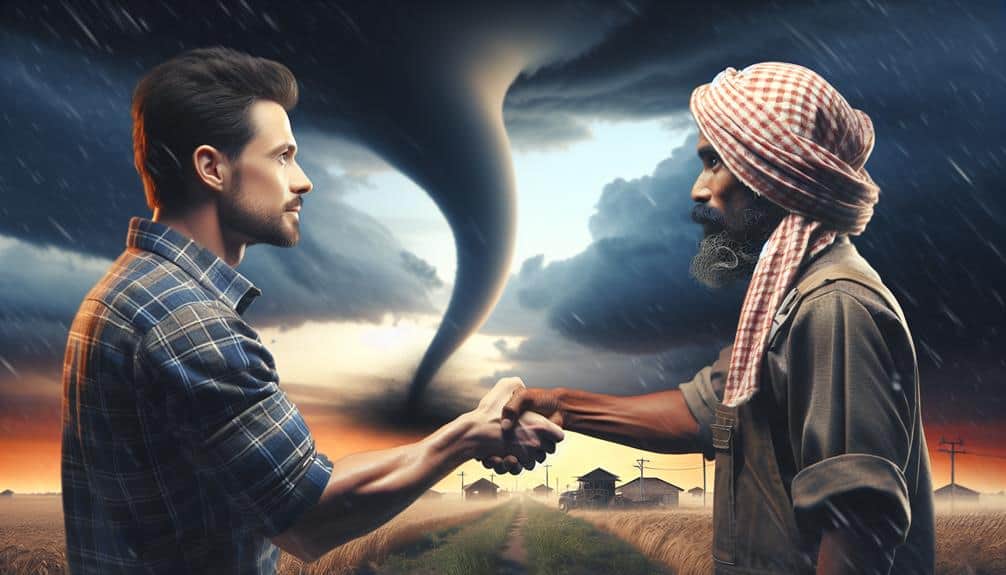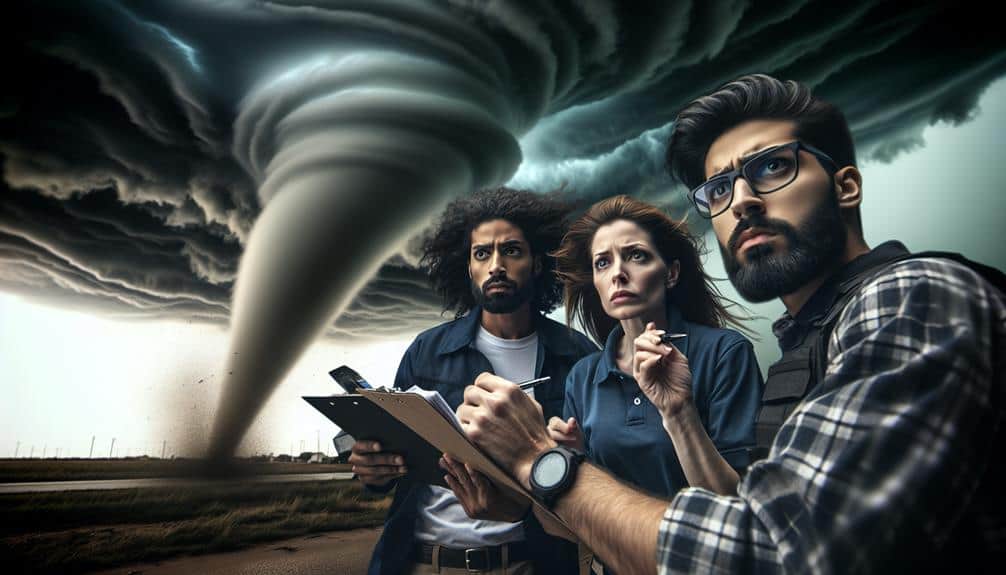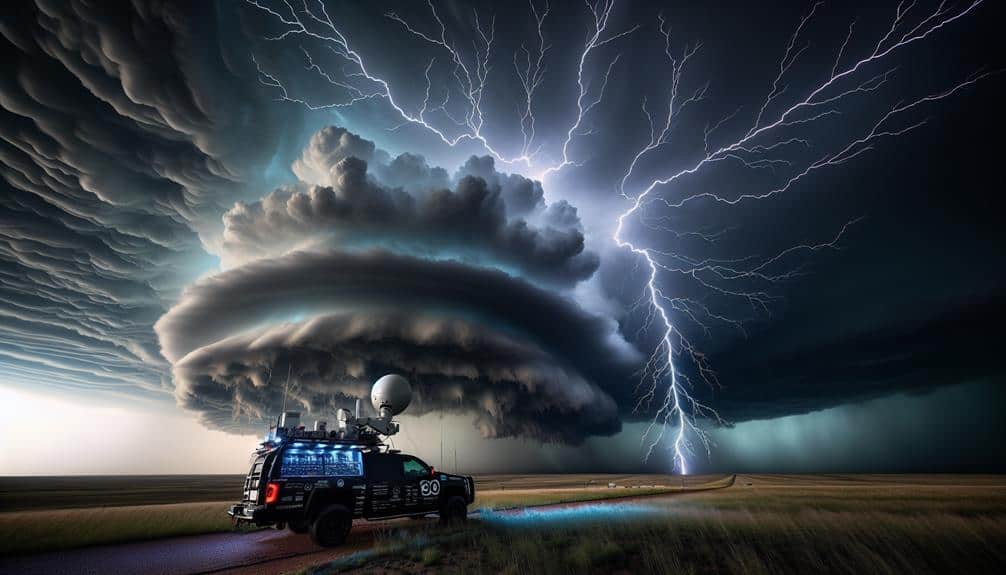When we engage in storm chasing, it's vital that we prioritize ethical considerations. We must respect local communities, acting with cultural sensitivity and minimizing our environmental footprint. Safety should always come first, with well-maintained equipment and clear emergency protocols. We need to adopt sustainable practices to lessen our ecological impact, such as reducing waste and supporting conservation efforts. Sharing accurate information without sensationalism further solidifies our role as responsible stewards of the environment. Building trust with locals through open engagement and truthful communication is crucial. Explore with us to understand how we can guarantee our passion aligns with moral and ecological responsibility.
Key Points
- Prioritize Community Safety: Ethical considerations help ensure the safety of local communities and minimize harm during storm chasing activities.
- Respect Local Cultures: They promote respect for local cultures and traditions, fostering positive relationships and community trust.
- Minimize Environmental Impact: Ethical practices reduce the ecological footprint and support the preservation of ecosystems and habitats.
- Ensure Accurate Information: They ensure the dissemination of truthful and precise information, avoiding sensationalism and misinformation.
Respecting Local Communities
When storm chasing, we must prioritize the well-being and respect the boundaries of local communities to guarantee our actions don't cause unnecessary harm or disruption. Engaging with these communities in a culturally sensitive manner helps us understand their unique experiences and values, making sure our presence is both respectful and minimally invasive.
By practicing community engagement, we can foster positive relationships and gain valuable insights from local residents who may have extensive knowledge about the terrain and weather patterns. This collaboration not only enriches our storm chasing experience but also reduces our ecological footprint, as locals can guide us to less disruptive routes and areas.
It's crucial to remember that our freedom to chase storms carries a moral responsibility. We should avoid blocking roads, disturbing property, or creating additional stress for those already facing the wrath of severe weather. Maintaining open communication with community members and emergency services ensures that our activities are aligned with their needs and safety protocols.
Ultimately, respecting local communities isn't just an ethical choice—it's a necessity for sustainable storm chasing. By prioritizing cultural sensitivity and community engagement, we can enjoy our passion while preserving the integrity and well-being of the communities we encounter.
Prioritizing Safety
Our primary moral responsibility in storm chasing is to safeguard the safety of ourselves, local communities, and the environment. By prioritizing safety, we guarantee that our pursuit of knowledge and adventure doesn't come at the expense of those around us.
Regular equipment maintenance is essential; it ensures our tools are reliable and effective, reducing the risk of malfunction during critical moments. Properly maintained equipment means we're less likely to find ourselves in hazardous situations, allowing us to focus on the storm itself.
We also need to establish and follow strict emergency protocols. Knowing how to act swiftly and correctly in dangerous scenarios can make all the difference. These protocols should include clear communication plans, evacuation routes, and contingency measures in case technology fails. By adhering to these guidelines, we not only protect ourselves but also set a positive example for others in the storm-chasing community.
Ultimately, our commitment to safety reflects our respect for life and nature. We must balance our thirst for freedom and exploration with the ethical imperative to minimize harm. By doing so, we contribute to a culture of responsibility and sustainability in storm chasing.
Minimizing Environmental Impact
In our pursuit of storm chasing, we must take active steps to minimize our environmental footprint. As enthusiasts of nature's most powerful phenomena, it's our moral responsibility to adopt sustainable practices. This means considering the impact our vehicles, equipment, and activities have on the environment. By using fuel-efficient or hybrid vehicles, we can reduce emissions and limit our carbon footprint.
Moreover, we should be conscious of our waste. Simple actions like packing reusable containers and ensuring we leave no litter behind contribute significantly to conservation efforts. It's essential to respect the natural habitats we traverse, avoiding unnecessary disturbances to wildlife and plant life.
We can also support local conservation efforts, whether through volunteering or donations, to help preserve the ecosystems we so passionately explore. By fostering a culture of respect and responsibility, we guarantee that our storm chasing adventures don't come at the expense of the environment.
Ultimately, adopting sustainable practices aligns with our desire for freedom—freedom to witness nature's wonders without contributing to their degradation.
Let's be trailblazers not just in chasing storms but in protecting the planet we cherish.
Accurate Information Sharing
It's crucial that we share precise information to secure our storm chasing activities don't harm the environment or mislead the public. When we prioritize data integrity, we guarantee that our observations contribute to a better understanding of storms without compromising the ecosystems we study. Ethical reporting demands that we provide truthful, precise data, which is essential for both scientific progress and public safety.
As storm chasers, we've a moral responsibility to act as stewards of the environment. Our reports should reflect the reality of the situations we encounter, avoiding sensationalism and misinformation. This honesty allows us to maintain the trust of those who rely on our data, whether they're researchers, meteorologists, or the general public.
By focusing on sustainability, we also make certain that our activities don't inadvertently cause harm. Accurate information sharing means we respect the delicate balance of nature, documenting storms without disrupting wildlife or natural habitats. It's about being conscientious of our impact and ensuring our pursuit of freedom in the wild doesn't come at a cost to the planet.
In essence, our commitment to precise information sharing upholds the integrity of our work and protects the environment we cherish.
Building Trust With Locals

By engaging openly and respectfully with local communities, we can foster trust and make sure our storm chasing activities are in harmony with their lives and the environment. Our commitment to community engagement ensures that we're not just visitors, but collaborators who respect and understand the local context. This involves listening to locals' concerns, acknowledging their knowledge of the area, and integrating their insights into our plans.
Transparency in reporting is essential. Sharing our intentions, methodologies, and findings openly builds credibility and assures locals that we're not here to exploit but to contribute positively. This transparency helps demystify our activities, reducing any fears or misconceptions. When locals see us as responsible and ethical, they're more likely to support our efforts and even provide valuable information that can enhance our understanding of storm patterns.
Furthermore, our moral responsibility extends to minimizing ecological impact. By adopting sustainable practices, we can protect the environment that locals depend on. This includes respecting wildlife habitats, avoiding unnecessary disruptions, and cleaning up after ourselves.
Ultimately, trust is built through consistent, ethical actions that reflect our respect for both the people and the planet. In doing so, we not only chase storms but also uphold the integrity of the communities we engage with.
Frequently Asked Questions
How Do Storm Chasers Balance Their Research Goals With Ethical Considerations?
We navigate ethical dilemmas by prioritizing research integrity, ensuring our work respects local communities and minimizes ecological impact. Balancing our goals with moral responsibility allows us to conduct meaningful studies while upholding our commitment to sustainability.
What Legal Regulations Govern Storm Chasing Activities?
Did you know over 1,200 tornadoes hit the U.S. annually? We must follow safety regulations and consider environmental impacts. Legal regulations guarantee we chase responsibly, balancing our thrill with moral and ecological responsibilities for sustainable storm chasing.
How Can Storm Chasers Be Trained in Ethical Decision-Making?
We can train storm chasers in ethical decision-making by using thorough training methods and decision tools that emphasize sustainability, moral responsibility, and ecological impact. Let's prioritize freedom while ensuring we protect our environment and communities.
What Are the Financial Implications of Ethical Storm Chasing?
Imagine a storm chaser's code as a compass guiding us through the stormy skies. By adhering to professional standards and accountability, we minimize environmental impact and guarantee our economic impact aligns with sustainable, responsible practices.
How Do Ethical Considerations Impact the Collaboration Between Storm Chasers and Meteorologists?
Ethical considerations shape our collaboration dynamics with meteorologists, ensuring we prioritize safety and minimize ecological impact. By addressing ethical dilemmas, we embrace our moral responsibility, fostering trust and promoting sustainable practices that respect both nature and freedom.


